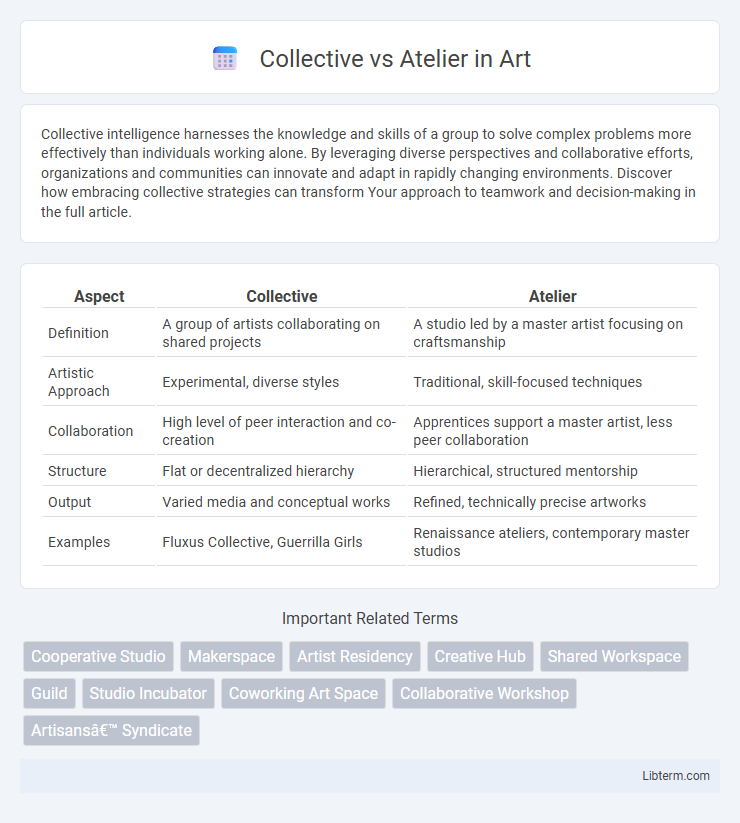Collective intelligence harnesses the knowledge and skills of a group to solve complex problems more effectively than individuals working alone. By leveraging diverse perspectives and collaborative efforts, organizations and communities can innovate and adapt in rapidly changing environments. Discover how embracing collective strategies can transform Your approach to teamwork and decision-making in the full article.
Table of Comparison
| Aspect | Collective | Atelier |
|---|---|---|
| Definition | A group of artists collaborating on shared projects | A studio led by a master artist focusing on craftsmanship |
| Artistic Approach | Experimental, diverse styles | Traditional, skill-focused techniques |
| Collaboration | High level of peer interaction and co-creation | Apprentices support a master artist, less peer collaboration |
| Structure | Flat or decentralized hierarchy | Hierarchical, structured mentorship |
| Output | Varied media and conceptual works | Refined, technically precise artworks |
| Examples | Fluxus Collective, Guerrilla Girls | Renaissance ateliers, contemporary master studios |
Understanding Collectives and Ateliers: Key Definitions
Collectives are groups of individuals collaborating informally around shared goals, often emphasizing community-driven creativity and democratic decision-making. Ateliers refer to structured studios or workshops led by a master artist or designer, focusing on specialized skill development and craftsmanship. Understanding these distinctions highlights how collectives prioritize collaborative ideation and ateliers concentrate on technical mastery and training.
Historical Origins of Collectives and Ateliers
Collectives originated in the early 20th century as democratic artist groups focused on shared creative goals and social ideals, often emerging from movements like Bauhaus and Constructivism that emphasized collaboration and equality. Ateliers trace their roots to Renaissance workshops where master artists trained apprentices in traditional techniques, maintaining hierarchical structures centered around skill transmission and craftsmanship. While collectives prioritize communal authorship and experimental practices, ateliers preserve classical methods through mentor-led instruction.
Structural Differences: How Collectives and Ateliers Operate
Collectives function as decentralized groups where members share decision-making and resources equally, promoting collaborative creativity without strict hierarchies. Ateliers operate under a hierarchical structure led by a master artist or designer who directs apprentices and assistants through specialized training processes. This structural divergence impacts project execution, with collectives favoring fluid roles and ateliers emphasizing skill mastery and sequential learning.
Core Values and Philosophies: Collective vs Atelier
Collective emphasizes collaboration, inclusivity, and innovation, fostering a community-driven approach that values diverse perspectives and shared creativity. Atelier prioritizes craftsmanship, meticulous attention to detail, and artistic expression, cultivating an environment where traditional techniques and individual mastery are paramount. The core philosophy of Collective revolves around collective intelligence and dynamic synergy, whereas Atelier centers on heritage, precision, and the artist's unique vision.
Artistic Output and Collaboration Styles
Collective emphasizes interdisciplinary collaboration, fostering diverse artistic inputs that result in dynamic, multifaceted works blending various media and styles. Atelier centers on a master-apprentice model, prioritizing craftsmanship and skill transmission to create highly refined, cohesive pieces within a specific artistic tradition. Artistic output in Collective often reflects experimental innovation, while Atelier produces polished, expertly rendered works rooted in classical techniques.
Decision-Making Processes in Collectives and Ateliers
Collective decision-making processes emphasize democratic participation, where members collaboratively discuss and vote on key issues to ensure diverse perspectives shape outcomes. In contrast, ateliers often rely on a hierarchical or mentor-driven approach, with expert guidance steering creative and operational choices. This difference highlights how collectives prioritize consensus and inclusivity, while ateliers focus on specialized expertise and streamlined directives.
Benefits of Joining a Collective
Joining a collective offers enhanced collaboration opportunities, enabling members to share resources, skills, and ideas, which fosters innovation and creative growth. Collectives often provide a supportive network that amplifies individual voices within a community, increasing exposure and access to larger audiences or markets. Membership also brings cost-sharing advantages, reducing expenses related to workspace, equipment, and marketing, thereby promoting sustainability for emerging artists or entrepreneurs.
Advantages of Working in an Atelier
Working in an atelier offers personalized mentorship and hands-on experience with skilled artisans, fostering a deep mastery of craftsmanship often unmatched in larger collective settings. The intimate environment of an atelier encourages close collaboration and immediate feedback, enhancing creativity and technical precision. Atelier spaces also provide access to specialized tools and techniques, creating unique opportunities for artists to develop a distinctive style and portfolio.
Challenges and Limitations of Each Model
Collective models often face challenges in coordination and decision-making due to diverse member interests and the need for consensus, which can slow down project execution. Atelier models may encounter limitations in scalability and resource allocation, as their smaller, specialized teams depend heavily on the expertise and availability of individual artisans. Both models must address issues of communication and resource management to optimize productivity and maintain creative integrity.
Choosing the Right Fit: Collective or Atelier for Artists
Choosing between Collective and Atelier hinges on an artist's collaborative preferences and work environment needs; Collective emphasizes community-driven projects and shared resources ideal for those seeking a vibrant creative network. Atelier offers individualized studio spaces and personalized mentorship tailored to artists who prioritize solitary practice and focused skill development. Assessing goals for artistic growth, desired level of interaction, and available support systems ensures selecting the right fit for professional advancement.
Collective Infographic

 libterm.com
libterm.com